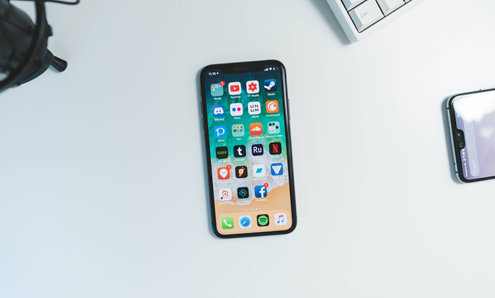A guide to Apple Pay for merchants: How it works and how to accept Apple Pay transactions
01 August 2025 | Published by Jodie Wilkinson
When it comes to mobile wallets, Apple Pay has become one of the leading choices for shoppers across the UK.
Apple Pay is a fast, secure, and increasingly popular mobile payment solution available on Apple devices like iPhones, Apple Watches, iPads, and Macs. Used by over 500 million consumers worldwide in nearly 100 countries, it continues to transform how consumers pay, and how businesses get paid.
In this guide, we’ll explore what Apple Pay is, how it works, and how your business can start accepting it with ease. Whether you're running a physical shop or selling online, Apple Pay can simplify the checkout experience for your customers and improve efficiency for your business.
What is Apple Pay?
Apple Pay is a digital wallet and mobile payment service developed by Apple. It lets users pay in store, online, and in apps without needing a physical card. Instead, payments are made using Apple devices by connecting a debit or credit card to the Apple Wallet app. It’s like contactless, just smarter, and faster.
You can learn more about different types of payment methods here.
How does Apple Pay work?
For customers, it’s easy to get started once a bank card has been added to the Apple Wallet. Payment steps may vary slightly depending on whether customers are shopping in-store or online.
In-store payments for customers
- At the till, authenticate your identity on your Apple device by using Face ID, Touch ID, or passcode to access your digital bank card.
- Hold your Apple device near the contactless (NFC) payment terminal.
- Wait for the payment confirmation.
Online payments for customers
- At checkout, click ‘Pay with Apple Pay’
- Authenticate the payment and your identity by using Face ID, Touch ID, or passcode
- Wait for the payment confirmation.
In-store and online payments for merchants
For merchants to accept Apple Pay in-store and online, they need NFC-enabled POS systems and online checkout solutions in order to process payments.
Near Field Communication (NFC) is technology that enables close-range, secure communication between devices and card readers. Or in other words, near field communication is what makes contactless and digital wallet transactions possible for in-person transactions.
At takepayments, we offer a full range of card payment solutions, like our A920 card terminals, tPOS systems and online payment solutions, that have built-in NFC technology and are ready to process Apple transactions.
Which devices work with Apple Pay?
Apple Pay is compatible with a range of Apple devices, including:
- iPhone 6 and newer
- Apple Watch (paired with a compatible iPhone)
- iPad (Air 2 and later, Mini 3 and later)
- Mac models with Touch ID or used with an iPhone/Apple Watch
Customers can use these devices for in-store, in-app, and online purchases.
Benefits of accepting Apple Pay in your business
If you run a restaurant, a retail stop, or anything in between, accepting Apple Pay can help you keep up with how your customers like to pay.
Here are the six main benefits of accepting Apple Pay in your business:
1. Faster transactions
One of the biggest advantages of using Apple Pay and other mobile payment options is the speed of transactions. Mobile payments are typically processed faster than traditional magnetic-stripe or chip-and-PIN cards, which helps reduce queue times at checkout. By simply tapping their phones, something most customers have on hand and ready, shoppers can complete purchases quickly and conveniently.
2. Improved customer experience
Recent data from our latest campaign found that mobile wallets are now the third-most popular payment method for in-person transactions. Offering Apple Pay, therefore, not only meets the customer expectations but also keeps businesses competitive.
Apple Pay is particularly powerful for mobile-first shoppers. If your business has a high volume of mobile transactions, enabling Apple Pay can significantly improve conversion rates at checkout.
3. Stronger security
Apple Pay uses tokenisation and biometric authentication (Face ID, Touch ID) for secure transactions to protect users. Data privacy is crucial in the UK due to GDPR regulations, and Apple Pay provides a secure, encrypted method for transactions. This gives your customers more confidence and a sense of security when making a purchase.
4. Higher customer spending & reduced basket abandonment
When the payment process is fast and effortless, customers are more likely to follow through on impulse purchases. One of the biggest challenges in e-commerce is basket abandonment. This can be caused by lengthy or complicated checkout steps, making the customer think twice before purchasing.
By offering Apple Pay as a quick and secure payment option, businesses can reduce the likelihood of customers abandoning their baskets. This, therefore, makes it a great benefit for businesses.
5. Easy setup and integration
Apple Pay typically provides a straightforward setup and integration process for merchants, especially when working with supported payment processors and platforms. If you're using a takepayments card terminal or POS system, Apple Pay is already supported and enabled as standard, meaning there’s no additional setup or cost involved.
6. No additional cost
Apple Pay offers benefits that go beyond customer experience, as it’s also cost effective for businesses. For those in retail, hospitality, or e-commerce, accepting Apple Pay typically doesn’t include any additional costs beyond standard merchant account charges. This makes it a financially accessible option for businesses of all sizes, from small local shops to large-scale online retailers.
How secure is Apple Pay for customers?
With banks and payment apps storing sensitive information like card details, addresses, and even passwords, it can make customers feel more cautious when it comes to making digital payments.
Apple Pay, however, offers a higher level of security compared to using a physical credit or debit card. With features like Touch ID and Face ID, only the customer can authorise a transaction on their Apple device. Using Apple Pay keeps the customers’ identity and card details safe as they are never shared with the merchant or even with Apple themselves on their servers.
This makes Apple Pay one of the most secure payment methods available today.
Here are the main security features:
- Tokenisation — Card numbers are never stored or shared. Instead, a unique token (Device Account Number) is used for transactions.
- Biometric authentication — Biometric payments require Face ID or Touch ID for added security.
- Encryption — Data is encrypted and stored in a secure hardware chip called the Secure Element.
- Secure Enclave — Ensures sensitive data like biometric information remains private.
- Remote lock — If a device is lost, ‘Find My iPhone’ can suspend Apple Pay without cancelling the actual card.
While Apple Pay is designed with privacy and security in mind, it’s important to understand that like all consumer payment providers it does collect some user data to improve its services.
Here are some key points to keep in mind:
- Apple Pay stores transactional data — However, it’s worth noting that this data remains anonymous, such as the approximate purchase amount, the approximate date and time, and if the transaction was successful.
- Apple Pay might share additional data — Apple may use or share data that can no longer be tied to the user in order to improve its products and services.
- Apple Pay might share device and account-related information — Apple may share account-related details and information about paired devices with the user's card issuer or bank. This is to help verify eligibility and for anti-fraud purposes.
Setting up Apple Pay for your business
Accepting Apple Pay for business is easier than you might think, especially when you're using takepayments' card machines or tPOS system. Below is a step-by-step guide tailored to help you get set up, whether you're running a physical shop, taking payments on the go, or selling online.
Step-by-step: How to set up Apple Pay with takepayments
1. Choose your payment solution
All takepayments terminals are Apple Pay ready out of the box. Depending on your business needs, choose from:
- Countertop Card Machines — ideal for fixed locations like retail checkouts.
- Portable Card Machines — great for businesses like restaurants or cafés.
- Mobile Card Machines — perfect for on-the-go businesses such as tradespeople or market stalls.
- tPOS — our all-in-one touchscreen till system with integrated Apple Pay support.
- Online payments — perfect for businesses needing website payments, and hospitality businesses looking for at-the-table QR code payments.
For more help with choosing the right payment option, read our guide to selecting the best card machine for your business.
2. Set up your terminal or tPOS
Once your card machine or tPOS arrives:
- Plug it in and power it on.
- Follow the on-screen prompts to connect it to your Wi-Fi or mobile network.
- Your terminal is pre-configured to accept Apple Pay so there’s no manual activation needed.
- For tPOS, Apple Pay works via the built-in payment terminal, seamlessly integrated with your point-of-sale system.
3. Connect to your payment processor
When you sign up with takepayments, we help you get set up with a suitable merchant account via one of our trusted acquiring partners. This is essential for processing Apple Pay and all other card payments.
- You don’t need to register separately for Apple Pay.
- Transactions from Apple Pay appear in your daily takings like any other card transaction.
4. Inform your staff
Train your staff to recognise and assist with Apple Pay transactions. Remind them that:
- Customers will tap their iPhone or Apple Watch to the card reader.
- Authentication (via Face ID or Touch ID) is required before the payment completes.
- There’s a £100 spending limit with Apple Pay from June 2025.
5. Start accepting payments
You’re now ready to accept Apple Pay in-store or via tPOS. Payments are instant, secure, and fully integrated with your transaction reporting.
For online businesses using takepayments’ ecommerce solutions, Apple Pay can also be enabled via compatible payment gateways. Our support team will guide you through the process, including:
- Enabling Apple Pay at checkout.
- Verifying your domain if required.
- Testing the payment flow before going live.
Why choose takepayments for Apple Pay?
No matter if you're selling in-person or online, takepayments provides tailored support to help you get up and running with Apple Pay.
- No extra fees or setup costs to accept Apple Pay.
- Pre-configured card machines ready to use on delivery.
- Support for all major Apple Pay-enabled devices.
- Ongoing customer support, available 7 days a week, to help you every step of the way.
Want help choosing the right solution? Contact our team to get started.
FAQs
Does Apple Pay charge a fee?
No, Apple doesn’t charge customers or merchants any additional fees for using Apple Pay. Standard card processing fees may still apply.
What’s the limit on how much you can pay using Apple Pay?
In the UK, the contactless payment limit is £100, as of June 2025.
What’s the difference between Apple Pay and Apple Wallet?
While they might sound very similar and are easy to get mixed up, there’s a clear distinction between the two. An Apple wallet is the app where users store their digital cards, tickets, and passes, and then Apple Pay is the technology that processes transactions using those stored cards.
Which banks support Apple Pay?
All major UK banks support Apple Pay, including Barclays, HSBC, Lloyds, Santander, and Nationwide. You can find a full list of supported institutions on Apple’s website.
Ready to accept Apple Pay?
Apple Pay offers speed, security, and convenience for your customers, and accepting it couldn’t be easier. So no matter what kind of business you run, if you’re a retailer, café owner, or tradesperson, offering Apple Pay can streamline your business and meet modern consumer expectations.
Explore our range of card machines with integrated Apple Pay today.




